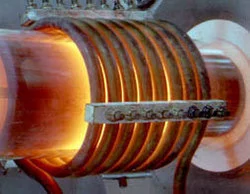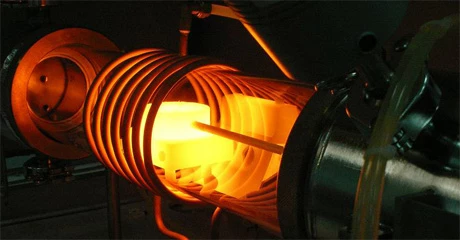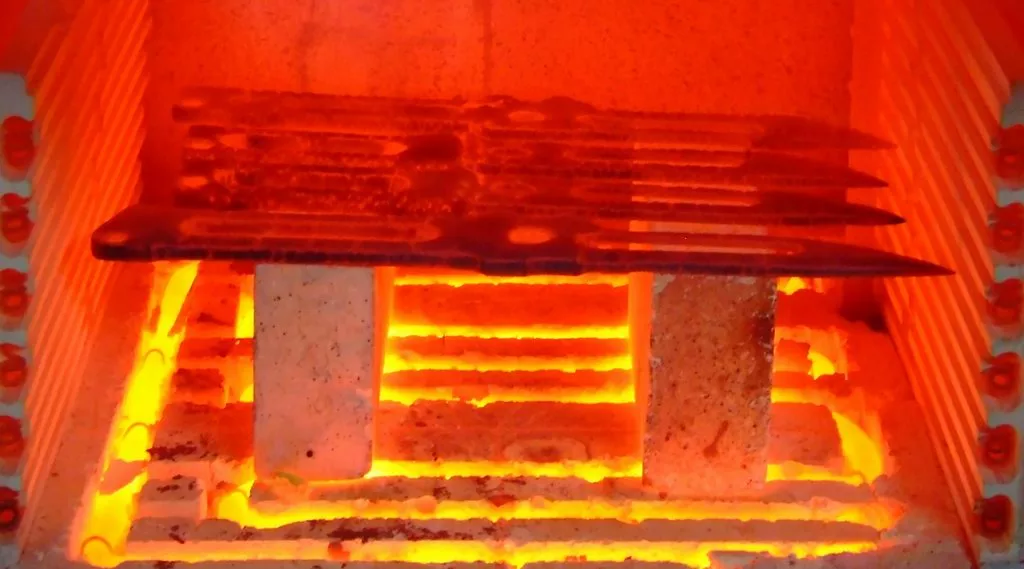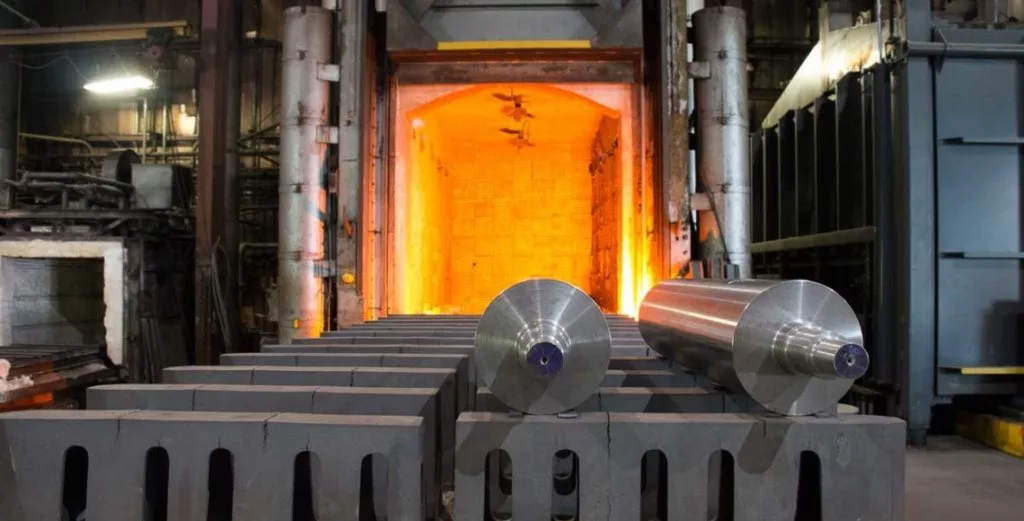Years ago, blacksmiths used heat to shape metals for wagon parts, horseshoes, and more. Once formed to the desired shape, the metal was cooled quickly. This usually made the metal a lot harder and less brittle. This is a basic process called heat treatment of metals. Modern machining and metalworking processes are now more precise and sophisticated.
Many different techniques help shape metals for various purposes. The heat treatment processes alter the ways metals react to precision machining. Heat treatment can change several properties of metals. Such properties include hardness, strength, formability, elasticity, machinability, and more.
There are several heat treatment methods today. Metallurgists continually work on improving the cost-efficiency and outcomes of the methods. When followed properly, the methods can give you metals with remarkable chemical and physical properties. Here, we’ll take a closer look at heat treatment types of steel and metals and their purposes.
What is Heat Treatment?
Generally, heat treatment of steel involves the heating and cooling of the material. The metal or alloy is heated to a specific temperature. Then, cooling occurs to harden the heated material. The process aims towards changing the microstructure of the metal. Also, it helps to bring out desired mechanical, chemical, and physical characteristics.
The alteration of these properties benefits the working life of the component involved. For example, there may be increased ductility, strength, surface hardness, or temperature resistance. Heat treatment is one of the essential aspects of the metal manufacturing process. This is because it helps to improve a metal part to withstand wear and tear better.
The general definition of heat treatment may be the heating and cooling of metals. However, the heat treatment process is more controlled. While the heating and cooling processes are in place, the shape of the working metal remains intact.
During this process, the structural and physical properties of the material change to serve the desired purpose. It could also be for further metal works. Heat treatment of steel or metals plays important role in various manufacturing stages.
How Does Heat Treatment of Metals Work?
Although there are many types of heat treatment, they follow similar processes. The first step involves the heating of the metal or alloy to the required temperature. Sometimes, the temperature goes up to 2400°F. It is held at the temperature for a specified amount of time before cooling.
While the metal is hot, the microstructure changes. This is the physical structure of the metal. The change in the structure ultimately results in a change in the physical properties of the metal. The ‘soak time is the amount of time used to heat the metal.

The soak time is a significant factor during the heat treatment process. A metal soaked for a more extended period will have more microstructure changes than that soaked for a shorter period. The cooling of the metal also plays a crucial role in the end result.
The cooling process may be quick – quenching. In other cases, the cooling may be done slowly in a furnace. The best type of cooling depends on the end result expected from the process. Therefore, it is important to consider these factors before starting the heat treatment of steel and metals.
Another factor also determines what properties of the metal change. This is the specific time for the heat treatment during a manufacturing process. Some metals may even require heating several times during manufacture. Therefore, it is important to understand the best ways to perform the operations correctly.
Benefits of Heat Treatment of Metals
Without the heat treatment of metals, there may be nothing like metal parts for devices and equipment. Even if they existed, they wouldn’t function in the right manner. For example, non-ferrous metal parts would be too weak for several applications.
Strengthening of metal and alloys, like steel and aluminum, occurs through heat treatment. The applications of many of these metals are in airplanes, cars, computers, and others. These products rely on metals with highly increased strength. This is to ensure adequate safety and improved performance.
The major mechanical property that changed after heat treatment is the shear strength. Others include tensile strength and toughness. Heat-treaded metals are usually stronger, ensuring durability. Therefore, there will be no need to replace expensive metal parts every now and then.
Using effectively heat-treated metal parts ensures the effective and cost-effective running of machines. Furthermore, the product will be a lot more efficient, even for the toughest applications. Also, there may be the need for extremely hard metals for some applications. The applications may be those requiring highly defined edges.
Heat treatment of the metals is one of the best ways to get the desired performance. It also helps to develop hard surfaces with ductile base materials. Asides from the application benefits, heat treatment is also beneficial to manufacturers.
A proper heat treatment process help relieves internal stresses. Consequently, this makes the metal easier to weld or machine. Processes such as hot forming may build stresses in steel materials over time. Therefore, these materials benefit greatly from heat treatments. In a nutshell, the benefits of heat treatment of metals include:
- Increases strength, making the material ductile or more flexible.
- It introduces wear-resistant properties to the metal.
- Relieves stresses, making the part easier to machine or weld.
- It improves brittleness.
- Can improve the electrical and magnetic properties of a metal.
Types of Heat Treatment and Their Purposes in Machining
As mentioned earlier, every heat treatment process involves heating and cooling. In this section, we’ll discuss the four major heat treatment types. You will also understand their unique purposes in machining.
Hardening
Hardening involves the heating of the metal material to a specific temperature. This temperature is the point at which the elements present in the metal go into the solution. The crystal lattice structure of the metal may have defects that present a source of plasticity. Heat treatment helps to address these defects.

It does so by bringing the metal into the solution of fine particles. This works to strengthen the metal material. Once there has been thorough heating of the metal to the required temperature, it is quenched as quickly as possible. Quenching helps the metal to trap particles in the solution. In some cases, technicians may add impurities to the alloy to further increase strength.
The purpose of hardening is to increase the strength of the metal. At the same time, it makes the metal more brittle while decreasing ductility. Therefore, it will help if you temper the metal after the hardening process.
Tempering
This is another heat treatment process that helps to increase the resilience of steel. Iron-based alloys are usually hard but often too brittle for certain applications. Tempering helps to alter the hardness, brittleness, and ductility of the metal. This is in a bid to make the machining process easier.

In this case, heating occurs at a temperature below the critical point. Lower temperatures tend to reduce brittleness and maintain hardness. Tempering helps to reduce the hardness caused by hardening. This way, you can develop new physical properties for your metal. Therefore, tempering should often follow hardening during heat treatment.
Annealing
This process is suitable for metals like steel, aluminum, copper, silver, or brass. Annealing involves heating the metal to a specific temperature. Then, you hold the metal at that temperature for some time for transformation. Then, air cooling takes place.

The cooling may occur slowly or quickly for silver, copper, and brass. However, the cooling of steel has to be gradual for effective annealing. Annealing does the opposite of hardening. It decreases the metal’s hardness while increasing its ductility. Thereby, it makes it easy to work on the metal. It is also a great way of fixing a weak metal. At the same time, it helps to relieve internal stresses in metals.
Normalizing
Normalizing is another form of annealing. In this case, the metal material is heated up to 200°F, which is higher than for annealing. The technician holds the metal at the critical temperature till transformation occurs. This heat treatment process requires air cooling after heating.

This process leads to smaller austenitic grains. Air cooling helps to produce ferritic grains that are more refined. It works to remove any form of internal stress from metals. Internal stresses may lead to metal failure. Therefore, it is crucial to normalize the metal. Then, hardening can ensure the success of manufacturing processes.
Conclusion
Heat treatment of metals is a great way of improving their mechanical properties of metals. Asides from the physical, it can also improve the electrical and magnetic properties of a metal. This further improves the compatibility of the part with other materials.
As you have learned, various heat treatment processes can help improve your products. However, you need the best hands to work on your project to get desired results.

RapidDirect makes it easy to get perfectly customized parts with heat treatment. We boast of facilities that process an extensive range of thermal processing operations. Our heat treatment processes are carried out by the best technicians and engineers in the industry. We are ready to leverage our expertise and experience to offer the best services. You can be sure of adequate support and products that meet your unique requirements. All these, you get at competitive rates.
FAQ – Heat Treatment of Metals
Heating to a specific temperature range can give more pure and harder metal. Heat treatment usually creates stronger metals. However, it is also possible that some treatments may make the metal weaker.
An increase in the temperature of metal will increase its surface area, volume, and length. Therefore, heat treatment expands the metal (thermal expansion). The degree of expansion will depend on the type of metal in use.
Every steel material has its upper and lower limit for toughness. The temperature at which a steel’s toughness drops refers to the ‘Ductile to Brittle Transition Temperature.’ This is usually around 75°C for 0.01% carbon steel. The temperature differs for various types of steel materials.


